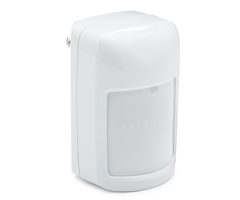How Are Motion Sensors Wired?
Motion sensors are normally wired with 4-wire connections. Most use Normally Closed (NC) wiring that is wired in Series. Two (2) of the wires are for power, and the other two (2) are for data. The power wires go to the ECP bus for the panel. The data wires go to the specific zone terminals.

Motion sensors are used for detecting movement in an area. Most work using passive infrared (PIR) technology. This involves looking for the changes in infrared (IR) energy that occur with movement. If a person or large object comes within the sensor's field of view (FOV), then the sensor will detect the change in IR energy. The sensor will then alert the panel. The system will then respond based on the Response Type for the associated zone.
Motion sensors use a small amount of electrical power for their basic operation. For hardwired motion sensors, this power is usually drawn from the panel, though it could also come from a separate DC power supply. The motion sensor will need connections for power. It will also need connections for zone status transmission. Most hardwired motion sensors use two (2) wires for each of these connections. In other words, they use two (2) wires for power and another two (2) wires for data, or four (4) wires total. The power wires will go to the auxiliary power terminals, which also supply power to the system's keypads. The zone status wires will be connected at the specific zone terminals.
Most wired motion sensors use Normally Closed wiring. This is also commonly referred to as Series wiring. If you have multiple motion detectors wired to the same zone, they will be wired in Series. Some hardwired motion sensors will allow a user to choose between NC wiring and Normally Open (NO) wiring. These are commonly referred to as "Form C" motion sensors.
Below you see a common motion terminal block layout. This sensor has a Normally Closed alarm loop and a Normally Closed tamper circuit. For this reason, we wired the tamper in series with the alarm loop, allowing us to use a single zone for both. When the system is armed and the motion is active, either removal of the cover (and in some cases removing the motion from the wall) or motion within the field of view will cause an alarm. When the system is disarmed, both will cause a fault. Some panels may have additional programming options to allow the tamper to cause a trouble rather than a fault:

The wiring layout below shows a normally closed motion with no resistor and the tamper terminals are unused. You could wire the tamper to a separate zone, if desired, and program it for a Trouble response, or possibly a Day/Night response. This would allow you to tell the difference between a tamper situation and an alarm event:

Normally Open wiring is also referred to as Parallel wiring. But most motion sensors will use NC or Series wiring. Check the documentation for your motion sensor to find out which wiring configuration to use. We recommend using 18-gauge stranded cabling for motion sensors when possible. However, slightly thinner wire (e.g. 22-gauge) should still work just fine. Just make sure the connections are nice and secure. It is also recommended that you use an end-of-line resistor (EOLR) with your motion sensors. This way, the system will know if anyone tries to tamper with or disconnect these devices.
Below is shown a Form C capable motion detector. The alarm zone can be wired using Common (C) and Normally Closed (NC) or Common (C) and Normally Open (NO). There is also a normally closed tamper circuit available. On panels that allow you to program different responses for a zone that is either opened or shorted, such as the VISTA-128BPT, the tamper circuit could be wired in series with the alarm loop, so that a single zone can be used to monitor both conditions. In our example, we show the alarm loop only, and it's wired for NO with the end-of-line resistor in parallel. Take a look at our first diagram to see the difference between series and parallel placement of the resistor:

Did you find this answer useful?
We offer alarm monitoring as low as $10 / month
Click Here to Learn MoreRelated Products



Related Categories
- Wired Motion Detecting Sensors
- Wired Motion Detecting Sensors
- Wired Ceiling-Mount Motion Detector
- Wired Ceiling-Mount Motion Detector
- 360-Degree Wired Motion Sensors
- Answered
- Answered By
- Julia Ross

